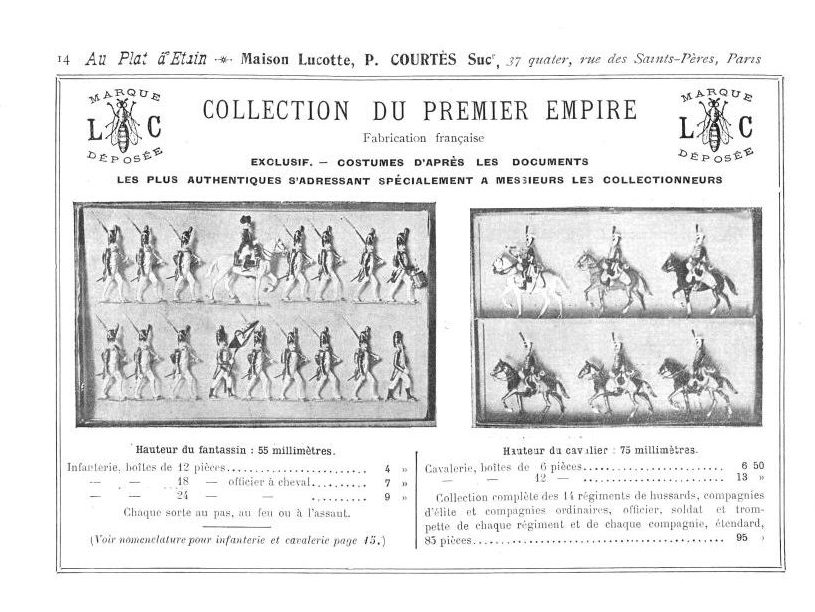Once upon a time Lucotte
Once upon a time Lucotte
From the outset, the Lucottes were decorated with great precision, at a high level of quality. An old catalog describes the Empire figurines as an “artistic collection” with “uniforms from the most authentic documents”. The documentation used for the precise decoration of the Lucotte seems to come from two volumes of extremely detailed illustrations probably specially made for the Maison Lucotte in 1906 (vol Il) and before (cf Don Grant, Mignot-Lucotte Historical Review, number 6 pp 300-303). After the purchase of Lucotte by CBG Mignot in 1928, painted cards attached to models were used as decoration guides to simplify and standardize decoration.
Lucotte’s infantry was sold mostly in boxes of 12, 18 or 22, plus an officer on horseback. Infantry sets usually consisted of a foot officer, a flag officer, a drum or cornet, plus infantry, although a mounted officer was usually added, instead of two infantries, in the larger compositions. Cavalry was usually presented in boxes of six or twelve. However, boxes of one figurine or dioramas were also available.
In cavalry ensembles, boxes of six usually consisted of a trumpet and five horsemen, although early sets of hussars usually consisted of an officer, a trumpet, and horsemen from ordinary and elite companies. Larger sets usually consisted of one officer, one standard, one trumpet and nine horsemen from ordinary companies, elite companies, or both.

The famous set of marshals, generals and aides-de-camp of Napoleon’s Grand Etat-major could be acquired in sets of sixteen or twenty-four mounted figurines offering “strict precision of uniforms, special manufacturing quality and a label with the name of each rider”.
The examination of a catalog from after the First World War shows that an Empire rider, at 5.50 Frs (French currency at the time), cost more than two and a half times the price of a pedestrian, 2.10 Frs. A standard bearer or a drum were slightly more expensive at 2F45. It is interesting to note that the larger the set, the proportionally higher its price was. Thus, the box of twelve pedestrians cost 25F25 while the box of 24 cost 56 and had only one flag and one drum! A box of six riders cost 35F, and a box of twelve, 77. It is not surprising that large compositions are much rarer. The 24piece Grand Staff cost 245F, compared to 170 for the 16-piece set – about twice the normal cavalry prices.
This synthesis of the history of Maison Lucotte is drawn from
the remarkable work of Mr. JOSEY Lenoir